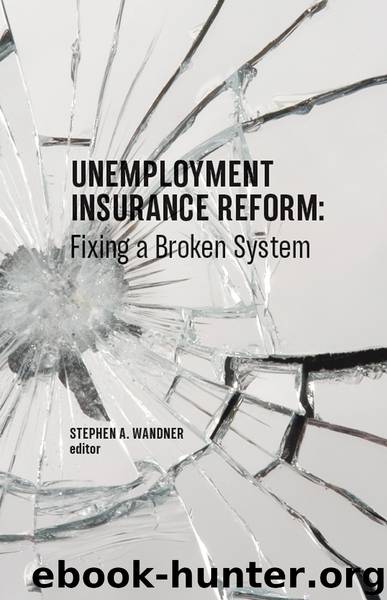Unemployment Insurance Reform: Fixing a Broken System by Stephen A. Wandner ed

Author:Stephen A. Wandner, ed.
Language: eng
Format: epub
Publisher: W E Upjohn Institute
SOURCE: Data from “Significant Provisions of State Unemployment Insurance Laws,” various issues through July 2016. The maxima can change in January and June of each year. Figure 4.1 shows annual duration with weights of 0.55 and 0.45 for the two periods.
The approach followed here is to fit recipiency rate regressions for a period prior to the reduction in potential benefit duration, project the recipiency rate for later periods, and examine projection errors with particular attention to periods of shorter potential duration. A recipiency rate regression using annual data was fitted for each state for the years 1967 to 2007. Each regression used two explanatory variables: the state’s current total unemployment rate (TUR) and TUR lagged one year. Table 4A.1 presents the regressions.
Table 4A.1 shows that state-level recipiency rates display considerable short-run noise. Although the table has regressions for 51 UI programs, the eight highlighted in bold in the table are shown in Figure 4.2. Seven of the eight have adjusted R2s of less than 0.50, and all eight standard errors of the estimates are between 0.034 and 0.049. The coefficient patterns for the TUR variables are consistent. All current TURs have positive coefficients, and six have t ratios of at least 2.0, a common threshold for statistical significance. All eight lagged TURs have negative coefficients, and all eight have t ratios of least 2.0. The recipiency rate increases in years with high unemployment rates but then decreases when the lagged unemployment rate is high.
The regressions in Table 4A.1 were used to project recipiency rates through 2015. Two sets of average projection errors are shown in Table 4.3: 2008 to 2011 and 2012 to 2015. Note that all projections are for years beyond the regressions’ estimation periods, which ended in 2007, and that nearly all of the reductions in average potential duration below 26 weeks occurred during 2012 to 2015, the latter of the two four-year projection periods.10
The reduced maximum durations would be expected to cause larger projection errors during 2012 to 2015 as compared to 2008 to 2011, and the average projection errors for the two periods generally support this expectation. Six of eight averages are negative (i.e., they are overprojections) in the first period, but all eight are negative in the second. Six of eight equations were overprojecting by larger amounts during the first period relative to the second one; that is, the changes in these four-year averages are negative in all states but Georgia and Kansas. When the changes are examined for individual states (bottom row of Table 4.3), note that five changes are more negative than –0.045 (Florida, North Carolina, Michigan, South Carolina, and Arkansas).
Table4.3Average Projection Errors by State, 2008 to 2015
Download
This site does not store any files on its server. We only index and link to content provided by other sites. Please contact the content providers to delete copyright contents if any and email us, we'll remove relevant links or contents immediately.
| Automobile | Business |
| Casualty | Health |
| Liability | Life |
| Property | Risk Management |
The Secrets of Successful Financial Planning by Dan Gallagher(1516)
A Knight's Reward by Catherine Kean(1326)
An American Sickness by Elisabeth Rosenthal(1249)
Against the Gods by Peter L. Bernstein(1101)
FREAKONOMICS by levitt steven d(1087)
America's Bitter Pill: Money, Politics, Backroom Deals, and the Fight to Fix Our Broken Healthcare System by Steven Brill(1073)
SuperFreakonomics by Steven D. Levitt(1073)
America's Bitter Pill by Steven Brill(1050)
The Globetrotter's Guide to Travel Insurance: Travel Smarter, Pay Less, Get the Right Coverge (The Savvy Traveler Series Book 1) by Bauche Michael & Bauche Yvonne(1024)
Risk Management Framework by James Broad(1024)
A Practical Introduction to Security and Risk Management by Bruce Oliver Newsome(1020)
2019 Social Security & Medicare Facts by Michael D. Thomas(1015)
Strategic Risk Taking: A Framework for Risk Management by Aswath Damodaran(1011)
The New Frontier Investors by Jagdeep Singh Bachher Adam D. Dixon & Ashby H. B. Monk(1004)
Game Changers by Rudolf Taschner(1002)
How Our Days Became Numbered: Risk and the Rise of the Statistical Individual by Dan Bouk(992)
The 8 Characteristics of the Awesome Adjuster by Carl van Lamsweerde(927)
SUPERFREAKONOMICS by levitt steven d(922)
The Advisor Playbook: Regain Liberation and Order in your Personal and Professional Life by Duncan MacPherson & Chris Jeppesen(884)
